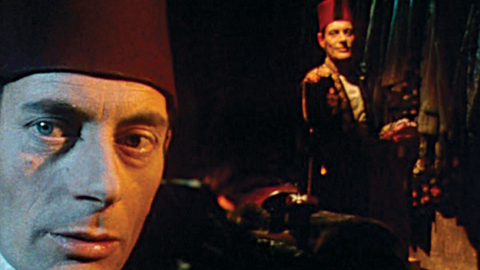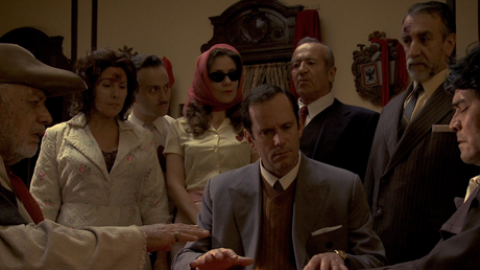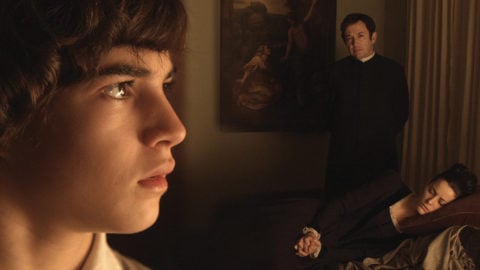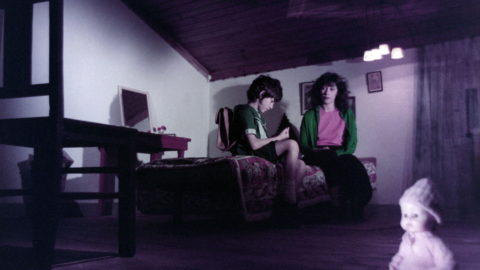The One Thousand and One Nights of Raúl Ruiz
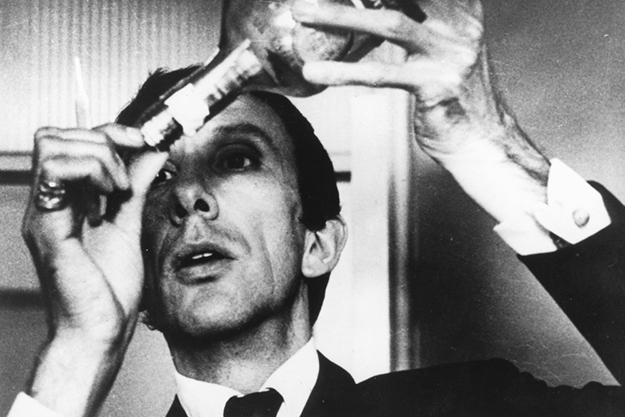
Three Sad Tigers
With over one hundred films to his credit, Raúl Ruiz was perhaps the most prolific filmmaker of his generation. However, his filmmaking exploits were so far-flung and diverse that it is virtually impossible to compile a definitive filmography. Born in Chile in 1941, Ruiz first received international acclaim with his debut feature, Three Sad Tigers (1968), which won the Golden Leopard at the Locarno Film Festival in 1969. With this success he rose to the front ranks of the New Latin American Cinema. Following the coup d’état led by Pinochet in 1973, Ruiz fled Chile with his wife, fellow filmmaker Valeria Sarmiento, and made France his home and base of operations.
In Europe, Ruiz recast himself as auteur-for-hire. He took television commissions and small regional productions and transformed them into such inventive and uncompromisingly personal films as The Hypothesis of the Stolen Painting (1978), Three Crowns of the Sailor (1982), and The Blind Owl (1987). He worked at a frenetic pace and always on several projects at once—as if to prove that any commission, no matter how small, can be the occasion for something highly original. He spoke of his baroque visual style in economic terms, comparing it to an already crowded restaurant that tries to accommodate as many patrons as it can. One is reminded of Orson Welles’s quip about his habit of placing an object in the extreme foreground. He maintained that it was a way to economize on actors, by having less of the screen to fill. One also thinks about Welles’s creative handling of limitations while making Othello (1952): his use of doubles for featured actors; shooting scenes in multiple locations or countries; setting one scene in a bathhouse because the actors’ costumes had not arrived. Like Welles, Ruiz was a master at shaping his fictions around the conditions at hand. He shot City of Pirates (1983) in three weeks, writing the script day by day, and made a second feature, Vanishing Point (1984), during the same time period. Astonishingly, he continued to make film after film in this fashion, seemingly unconcerned about whether or not they would reach an audience or a screen.
In the Nineties Ruiz embarked on larger art-house projects featuring stars such as Marcello Mastroianni, Catherine Deneuve, and John Malkovich. Yet, he showed no sign of slowing down, and alternated these higher-profile productions with experimental low-budget films. He believed that working quickly and incessantly freed him to make the films he might not have dared to make otherwise—that is, if he became too precious about each project or too concerned about a particular film’s reception. Ruiz conceived of film as something necessarily fragmented and incomplete, a ruin. Consequently, he was more concerned with the process of making films than with polished, finished works.
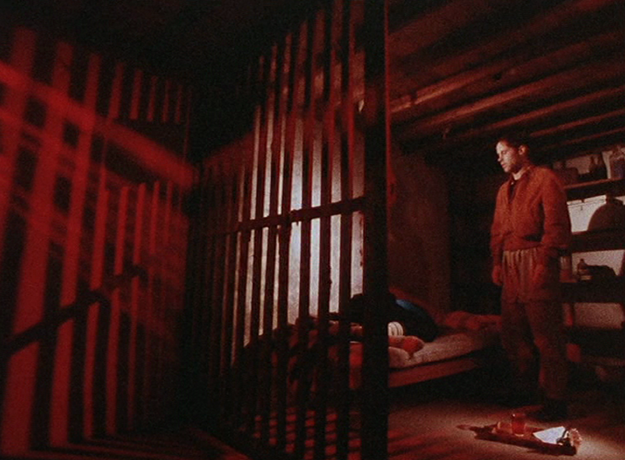
City of Pirates
For Ruiz, the cinema is primarily an art concerned with the production of monsters. The world of his films is unstable and unpredictable: characters suddenly divide in two or metamorphose into other people or things; familiar spaces become alien; temporality is reversible and can contract or expand. The fantastic elements of Ruiz’s stories seem to grow out of an inverted or perverse logic. His narratives are often generated by plays on words and other games with language. As in the works of Lewis Carroll or Raymond Roussel, a pun may spawn a fictional monster. When worms writhe horribly from sores on the sailors’ skin in Three Crowns of the Sailor, it is partly because of the double meaning of the phrase “Il font des vers”: “vers” in the sense of “worms” and “verse of poetry” (since the sailors recite poetry and speak in rhymes).
The image of a mutilated body or a corpse particularly haunts Ruiz’s oeuvre. Many of his fictions are based on this premise (Dog’s Dialogue [1977]), The Territory [1981], The One-Eyed Man [1980]). In The One-Eyed Man, a murderer is discovered at the center of a circle formed by parts of his victim’s body. When I asked Ruiz a number of years ago about his obsession with dismemberment, he told me that as a child he saw many people mutilated by trains in front of his house, and that it was normal to send schoolchildren to autopsies to study anatomy. “Later,” he continued, “it became other things for me. I discovered the story of Isis and Osiris; I identified it with the experience of exile. Of course, at some point it became a central metaphor of my work.” The mutilated body is also a metaphor for cinema itself. The “body” of a film is always fragmented, composed of thousands of pieces of organic matter. The Spanish word for film, “película,” comes from the Latin “pellis” or “skin,” so that a film is like a strip or collage of grafted skin. The early spectators of cinema perceived a close-up as a cut-off head, and Ruiz once spoke of making a film in which, when cutting from a master shot to a close-up, it would mean that a character had been decapitated.
Ruiz shares this taste for the fragment, for images of torment and death with the baroque poets and dramatists (his cinema has been described as “neobaroque” or “hyperbaroque”). All these elements converge in the notion of allegory, which is a representation of an abstract or spiritual meaning through concrete or material forms. Nature is hollowed out of its life and becomes a sign. Central to this baroque vision is the emblem—a montage of visual image and linguistic sign, out of which the meaning is read like a picture puzzle. The emblem of the skull, for example, represents human vanity and the transitoriness of earthly power. Indeed, the image of the skull recurs obsessively in Ruiz’s films, occasionally in a humorous way (the memorable shot from City of Pirates with a skull in the foreground wearing sunglasses). Baroque dramas were melancholy contemplations of decay and disintegration. In his study of German baroque drama, Walter Benjamin wrote that the only pleasure the melancholic permits himself is allegory. He defined allegory in the following way: “Any person, any object, any relationship can mean absolutely anything else.” It is this arbitrary, connecting aspect of allegory that fascinates Ruiz: “You make an allegory and this allegory touches an element of real life and makes this element become an allegory of something else, of some distant object.” Cinema for Ruiz is above all a way to create bridges across disparate objects and worlds. This relates to the notion explored in his book Poetics of Cinema that “the images that together make up a film determine what type of narration will structure the film and not the contrary.”
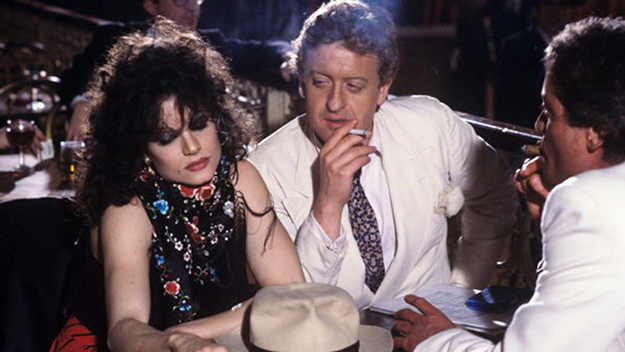
Three Crowns of the Sailor
The actors in Ruiz’s films behave in an artificial and inconsistent way; he refers to them as ghosts. However, their performances have a mesmerizing quality which arises from the timbre of their voices; the slow phrasing of their dialogue; their seductive gestures (the striptease in Three Crowns of the Sailor, or the dance of the seven veils in The Blind Owl). The seduction works in counterpoint to the opacity of the dialogue. The hypnotic voiceovers, which evoke B-movies by Jacques Tourneur or Edgar G. Ulmer, envelop us in the illusion of a coherent narrative, whereas there is only the surface of the screen. As a character in Three Crowns of the Sailor says: “The world has two dimensions . . . the world is a lie.” In this sublime film a sailor condemned to eternal exile searches for truth, for a meaning to his life. He finds no point of anchorage, no spiritual home or identity—only a seemingly infinite accumulation of stories and paradoxes. Even a woman’s nudity—the one truth the sailor believes he can rely upon, is only a trompe l’oeil. When the beautiful femme fatale Mathilde performs a striptease for the sailor, he is horrified to discover that her nipples and vulva are only prostheses, and that her mouth is her only orifice. Nudity is impossible in Ruiz’s world because the body of an actor is already a fiction, a simulacrum. The film abounds with such anomalous bodies: there is a virgin prostitute, an old man trapped in the body of a young boy; sailors who eat but who don’t defecate, excreting instead the above-mentioned worms which then metamorphose into butterflies. The protagonist of Three Crowns of the Sailor will discover that he is the only one alive aboard a ship of phantoms. In fact, many of Ruiz’s films begin with the paradoxical premise that all the characters are dead. For Ruiz, this premise merely multiplies the fictional possibilities: all stories are possible because the characters are freed from the desires of the living and are no longer bound by the laws of the physical world. Although death and the monstrous are omnipresent in his work, his films are never morose. In fact, they are pervaded by a perverse and irreverent sense of play. In Ruiz’s work, melancholy is always counterbalanced by the ludic. A character in Memories of Appearances (1986) asks another: “What does it mean to be Chilean?” The other responds: “It means to be dead.” “Dead of what?” asks the first man. “Dead of laughter,” the other replies.
Fascinated by experimentation, Ruiz explored the kinds of special effects that have largely been abandoned since the early cinema. However, for Ruiz, special effects take on a supplementary function. The effects in his films are meant to be visible—to draw attention to themselves as effects. He believes that such effects are interesting not because they transform objects but because they themselves become poetic objects superimposed over other objects. As he explained: “I simply use mistakes and accidents in such a way that you no longer believe what the special effect shows, but see the artificiality of the effect itself.” Ruiz gave the example of King Kong (1933). That the King Kong puppet moves in an erratic way because of the stop-motion animation somehow makes what is happening on screen more terrifying—not terrifying in relation to the narrative, but uncanny in its own right. Many of the signature effects Ruiz employs are quite simple: split-diopter lenses (which allow one to maintain focus on distant and close objects at the same time), colored filters, distortions achieved through the use of wide-angle lenses. Others are more involved, using multiple exposures, mirrors, and paintings on glass placed before the camera. Such experiments led him to collaborate with some of the cinema’s greatest visual alchemists—most notably Henri Alekan (Jean Cocteau’s cinematographer) and Sacha Vierny.
Paradoxically, almost miraculously, this cinema—which pushes the disruption of narrative coherence to its limit, to the point where nothing can be taken at face value, where the background of every image is another image—nevertheless succeeds in engaging and enchanting us.
Ethan Spigland is a Professor in the Humanities & Media Studies Department at Pratt Institiute. He is also an award-winning filmmaker, visual artist, critic, and curator.



